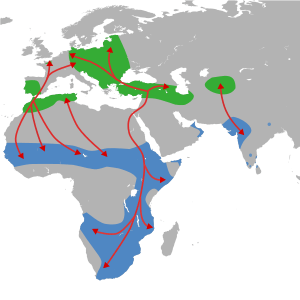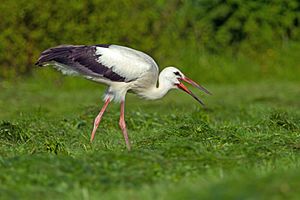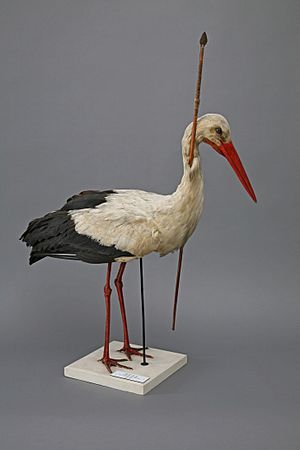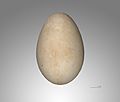White stork facts for kids
Quick facts for kids White stork |
|
|---|---|
 |
|
| Conservation status | |
| Scientific classification | |
| Genus: |
Ciconia
|
| Species: |
ciconia
|
 |
|
| Approximate ranges and routes | |
| Synonyms | |
|
|
The white stork (Ciconia ciconia) is a large, beautiful bird that belongs to the stork family, called Ciconiidae. Most of its body is white, but its wings have black feathers. Adult storks have long red legs and long, pointed red beaks. They are usually about 100 to 115 centimeters (39 to 45 inches) tall, from the tip of their beak to the end of their tail. Their wings can spread very wide, from 155 to 215 centimeters (61 to 85 inches)!
This amazing bird is part of many old stories and legends. The most famous one is about storks bringing babies to families.
Contents
What Does a White Stork Look Like?
The white stork is a big bird. Like all storks, it has long legs, a long neck, and a long, straight, pointed beak. Its feathers are mostly white, but its flight feathers and wing coverts (smaller feathers covering the main wing feathers) are black. Adult storks have bright red beaks and red legs.
White storks have long, wide wings. This helps them to soar high in the sky, using warm air currents to glide without much effort.
When a baby white stork hatches, it has short, soft, whitish down feathers. As they grow, their beaks slowly turn red, starting from the part closest to their head.
Where Do White Storks Live?
White storks live in many different places around the world. During the summer, they can be found across Europe, especially in Spain, North Africa, and a large part of eastern and central Europe. Poland is a very important place for them, as about 25% of all white storks live there! They also live in parts of western Asia.
Some storks, about 1,450 of them, live in central Asia, between the Aral Sea and western China. White storks are known for their long migrations. They travel to many parts of Africa and India for the winter. Sometimes, they are seen in places like Finland, Iceland, Ireland, and Norway, even though they don't usually breed there. In recent years, they have started to spread into western Russia too.
Stork Homes and Food
White storks love to find their food in grassy meadows, farmlands, and shallow wet areas. They try to avoid places with tall grass or thick bushes.
They prefer to build their nests in areas with open grasslands, especially if the ground is wet or gets flooded sometimes. They don't like areas with lots of trees or shrubs as much. In Africa, where they spend the winter, they also use grasslands, wetlands, and farms to find food.
White storks are carnivores, which means they eat meat. They eat a wide variety of animals, including:
- Insects
- Fish
- Frogs and other amphibians
- Reptiles
- Small mammals (like mice)
- Small birds
They usually find their food on the ground, among short plants, or in shallow water.
Amazing Journeys: White Stork Migration
White storks are known for traveling very long distances. They spend their summers in Europe, northwestern Africa, and southwestern Asia. When winter comes, they fly all the way to Africa, sometimes as far south as South Africa, or to the Indian subcontinent.
When storks fly between Europe and Africa, they avoid flying over the Mediterranean Sea. This is because they rely on warm air currents, called thermals, to help them soar and save energy. These thermals don't form over large bodies of water. So, they take longer routes, either going around through the Middle East in the east or through the Strait of Gibraltar in the west.
White Stork Behavior
White storks are very social birds. You can often see thousands of them flying together during migration or gathered in their winter homes in Africa. Even when it's not breeding season, storks that aren't raising chicks will gather in groups of 40 or 50.
Sometimes, breeding storks will hunt for food together in small groups. You might also see storks grooming each other's heads. This can be parents cleaning their young, or even young storks preening each other.
A strange but clever thing white storks do to stay cool is to poop on their own legs! Their droppings contain a white substance called uric acid. When this evaporates, it helps cool their legs down. This is called urohidrosis.
White storks have also been seen using tools! They can squeeze moss in their beaks to drip water into the mouths of their baby chicks.
How Storks Communicate
Adult white storks don't make many sounds with their voices. Instead, their main way of communicating is by clattering their beaks loudly. This sound can be so fast it's been compared to a distant machine gun! They have a special throat pouch that helps make the sound even louder.
Adult storks can only make a very quiet hiss with their voices. However, young storks can make a harsh hiss, different chirping sounds, and even a cat-like "mew" sound when they want food. Just like the adults, young storks also clatter their beaks.
Storks use a special movement called the up-down display to talk to each other. In this display, a stork quickly throws its head backward so its head touches its back. Then, it slowly brings its head and neck forward again. They repeat this several times. This display is used as a greeting between storks and also as a way to show they are feeling threatened.
White Stork Life Cycle
White storks usually have one partner for the breeding season, but they don't stay with the same partner for their whole lives. Both the male and female stork work together to build a large nest out of sticks. They might use the same nest for many years!
Each year, the female stork usually lays one clutch of about four eggs. The eggs don't all hatch at the same time; they hatch one after another over 33 to 34 days. Both parents take turns sitting on the eggs to keep them warm, and both parents feed the young chicks. The young storks leave the nest when they are about 58 to 64 days old. Even after leaving the nest, their parents continue to feed them for another 7 to 20 days.
How Long Do Storks Live?
The oldest white stork ever found in the wild lived for 39 years! This stork had a special ring put on its leg in Switzerland so scientists could track it. Storks living in zoos or special centers have lived for more than 35 years.
Protecting White Storks
The International Union for Conservation of Nature (IUCN) says that the white stork is a species of "least concern". This means they are not currently in danger of disappearing. In the past, white storks actually benefited from humans clearing forests in the Middle Ages. However, changes in farming and new industries in the 1800s and early 1900s caused their numbers to drop in some parts of Europe.
Thanks to conservation efforts and programs to bring them back, white storks are now breeding again in countries like the Netherlands, Belgium, Switzerland, Sweden, and the United Kingdom.
White storks don't have many natural enemies. But they can get different kinds of tiny creatures living on them, like lice and feather mites. Their large nests can also be home to many different types of mites.
Storks and Baby Stories
One of the most famous stories about storks comes from European folklore. It says that storks are responsible for bringing babies to new parents! This legend is very old, but it became even more popular because of a 19th-century story called "The Storks" by Hans Christian Andersen.
German folklore said that storks would find babies in caves or wet areas and carry them to homes in a basket on their backs or held in their beaks. The babies would then be given to the mother or dropped down the chimney. Some stories even say that families who wanted children would leave sweets on their window sills to let the stork know!
Images for kids
-
Otto Lilienthal studied the flight of storks in 1889 while designing his glider. Sketches by his brother Gustav Lilienthal.
-
White stork picking at a dead young European rabbit (Oryctolagus cuniculus)
-
A man-made nest platform in Poland built as a conservation measure and to prevent storks disrupting electricity supplies through nesting on pylons. Three young white storks are on the top of the nest and two Eurasian tree sparrows are perching on the side of the nest.
See also
 In Spanish: Cigüeña blanca para niños
In Spanish: Cigüeña blanca para niños














